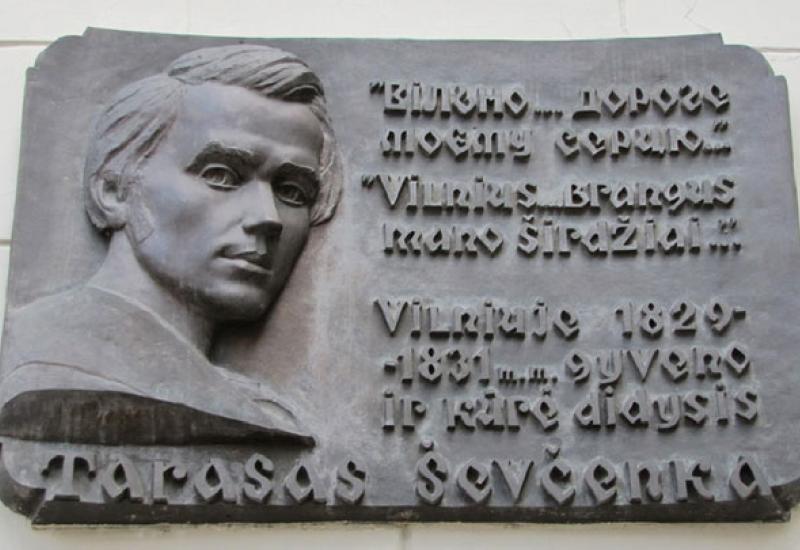Lithuanian capital Vilnius is one of those cities that have played in the life of the Ukrainian poet and artist prominent role.
... In 1828, Taras Shevchenko was taken to the landowner Paul Engelhardt (1798-1849). Managers of the landowner, seeing pictures of Taras, recorded in the list of the people, who were sent to a young gentleman in Vilna: "Can be used as a room painter." But in spite of this recommendation, first Taras was given to master's cook to train, and later he served master in role of "kazachok". And all his spare time Taras gave painting, which he was engaged at the age of twelve years.
Through a passion for drawing 6 December 1829 an event occurred which Shevchenko described in his autobiography: " The master and mistress left in resources (as in Vilna called Noble Assembly - I.M.) to a ball; in the house all was quiet, everybody fell asleep. Then he turned stolen treasures and chose from them Cossack Platov, and started reverently to copy. Already reached small kozachoks, prancing around burly hooves horse Cossack Platov as door was opening, and the master and mistress returned from the ball. The master furiously tore his ears, slapped for that, he says, that he could not only the house, the city burn The next day Pan told the coachman Sidorka flog him well, which was done thoroughly ".
After this ordeal the wife Paul Engelhardt Sofia started to look after Taras. She took Taras to their own workers, and took up his education. The boy was given access to the books from the library Engelgardts (but only in the absence of the master). Moreover, Sofia patiently explained Taras incomprehensible to him in the books of Polish words and phrases. It was here Taras first read some works by the outstanding Polish poet Adam Mickiewicz.
In addition, the Mistress allowed governess to give Taras French lessons. Sofia also welcomed Taras hobby painting and strongly supported him in this. Thus, in the Vilna University known portraitist Professor Ian Rustem (Jonas Rustemas) taught drawing. Study at the University of serf was not allowed, but Sophia through her links could solve this problem. No wonder the boy just adored Sofia Engelhardt.
So, Taras started going to art classes, where he quickly made friends with Franek Gusikovskiy, and through him - his sister Jadwiga. Jadzia did not know Ukrainian, Taras could read in Polish, understood well enough of all the others said, but could not yet speak Polish. However, Jadzia not very worried , as Taras knew by heart her favorite poems of Adam Mickiewicz, dedicated to her his first poems, written like Mickiewicz and in the language of Mickiewicz! And, in the end, sincere feeling flared between the young people. But over time, it is a beloved girl that betrayed the young man.
This happened in early 1831, after the departure of Paul Engelhardt to St. Petersburg for a new place of service. Taras asked Madam to go say goodbye to Yadzeyu and never returned. He decided to hide at Yadzi place, and then get rid of serfdom and, because he already knew the former serfs who bought new documents and now live as free people. However, Jadzia wished Taras to join the revolutionary-minded students of the Polish uprising of 1830-1831. Taras was not inspired by the war with unclear targets. Then Jadzia - first true love Taras - gave him to the head of Vilna garrison, after which he was sent as a fugitive to his master in Petersburg ...
The Vilnius period in the life of the young artist was short, but it contributed to the expansion and strengthening of world bold, free-thinking person. It was in Vilna Taras first heard and understood the slogan of Polish insurgents "For our and your freedom", and later applied it to the Ukrainian reality. He later recalled: "I (then - I.M.) first came to mind - and why we, miserable serfs, not to be the same people as the other free people."
Taras Shevchenko retained throughout his life a warm feeling to Vilna. In one of his poems called it "a city full of glory" (the poem "In Vilna, glorious garden"), and has written: "Vilno ... dear to my heart ..." These words of Ukrainian and Lithuanian can be seen today on the plaque on house of the Faculty of History of Vilnius University.
Another memorial plaque of the Ukrainian poet and artist with an inscription in Lithuanian and Ukrainian is placed on the house number 10 on the street Piles (Castle) in which Shevchenko lived for years 1829-1830. And in the New Town of Vilnius, in the west it borders the Old Town, Taras Shevchenko Street stretches, not far from the Embassy of Ukraine in Lithuania.
September 3, 2011 in a small cozy square of the Old Town of Vilnius a monument to Taras Shevchenko was unveiled. It represented the young men walking into the wind with a book in his hand, and which is yet to come all his victories and defeats, the hard tests and world fame. He looks at the city of his youth, where he first fell in love with all his heart, realized his destiny and that for your dream you have to fight.

